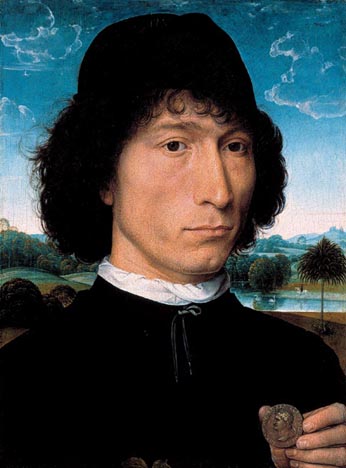|
Memling’s portrait of a man
A couple of weeks ago I posted the 15th century Netherlandish painter Hans Memling’s magnificent devotional portrait of Maria Portinari. Here is another Memling work that I especially like, his Portrait of a Man with a Coin of the Emperor Nero. With this portrait, as with Maria Portinari’s, Memling captures with precision—especially in his detailed rendering of the expression in the lower part of the subject’s face, focused on the contractions of the muscles around his mouth—a moment in a very specific person’s this-worldly consciousness, even as he shows that person existing in a transcendent framework of Christian experience, which is nevertheless taking place in the here and now. These are pictures of the way human beings are meant to be, living in the ordinary world and in God’s world at the same time.
The subject is thought to be Bernardo Bembo, a Venetian humanist, patrician, and ambassador, and the Platonic lover of Ginevra Benci, subject of the famous painting by Leonardo da Vinci, which was influenced by the Netherlandish school of portraiture. Unfortunately the image posted here is too dark to convey all the qualities that are visible in the splendid reproduction of the painting in the recent book, From Flanders to Florence. I had had the above thoughts about the combination of the secular/specific with the religious/transcendent in Memling’s portraits when I first looked at them, without having read anything about Memling. Then I opened up an article, “Realer than Life: Memling’s Portraits,” by Gail Leggio in the Fall 2005 American Arts Quarterly, which happens to have the Bernardo Bembo picture on the cover, and on the first page of the article I came upon the observation that his portraits are characterized by “uncanny verisimilitude infused with otherworldly significance.” That appears to be true even of the present portrait, though, unlike the portrait of Maria Portinari, it has no explicit religious content.
Richard B. writes:
Serenity and joy!Brandon writes:
I really enjoy your commentaries on art. I am far from an art connoisseur and your pro-Western perspective is refreshing. Things I would never notice.Carl Simpson writes:
Thanks for the presentation of the beautiful paintings of Hans Memling. The 15th century Dutch school in many ways is the apogee of Western visual artistic expression. There’s also a certain poignancy about it all, in light of the ongoing destruction of Holland as a nation. Such art is the product of living culture, existing in the here and now within the framework of transcendent Christianity. I would submit this work of art as refutation of Sayyid Qutb’s idea that Christianity contains a “hideous schizophrenia.” Posted by Lawrence Auster at April 03, 2006 11:59 PM | Send Email entry |
